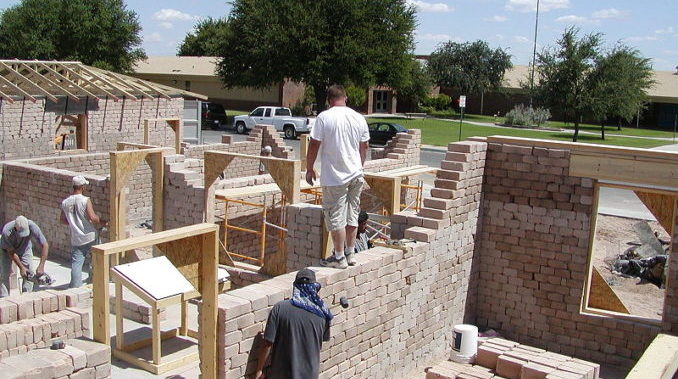
In 1943, Abraham Maslow published his influential paper, “A Theory of Human Motivation”, in which he outlined what became known as ‘Maslow’s hierarchy of needs’. The most widely familiar (and very basic) part of the theory covers physiological needs and states that every human needs air, water, food, rest, and shelter. The quality, or lack thereof, of our air, water, food, rest, and shelter, has profound effects on our health and our lives.
In first world countries, the benefits and advantages of shelter are easily taken for granted by the majority of people since most have never experienced the difficulties of life without a home. However, even in the U.S. there are people who cannot afford to own or even rent a home. If they are fortunate they live with relatives, or perhaps a friend allows them to sleep on a couch.
Elsewhere, people live in mud huts and other fragile structures that frequently need to be rebuilt after monsoon rains, hurricanes, floods, earthquakes, and other disasters. Around the world, the need for affordable, solid, and dependable shelter is not being met. Out of necessity, people have created new ways of building homes inexpensively that are strong and long-lasting.
Of the many newly developed alternative building technologies, Compressed Earth Block (CEB) is one of the most promising and accessible worldwide. CEB was developed in the 1950s, perhaps earlier, but it didn’t recieve much attention or application until the 1980s. It is both similar and different than adobe or brick.
To make adobe, mud is mixed with an organic material such as straw (to increase the strength of the finished block). The mix is shaped in a rectangle form, but not compressed. The blocks are left to dry in the sun before they’re ready to be used in construction. This ancient method of making building blocks has been around for thousands of years and is inexpensive but definitely low-tech. Water and earthquakes are not kind to adobe, but in many instances proper reinforcement can help adobe survive nature.
Brick is made of clay and fire-dried in a kiln. It contains no organic material, nor is it compressed. It’s waterproof, wind-resistant, low-maintenance, and higher-tech than adobe. However, it is relatively expensive despite being a mass-produced product and typically does not withstand earthquakes.
Compressed Earth Blocks are made by mixing clay and inorganic soil together, pouring the mix into a form, and using a mechanical press to compress the mixture. This creates a very strong building block. Portland cement may be added into the mix to make the blocks even stronger.
CEBs stack just like bricks or adobe but they can be made with ‘studs’ on the top of each block with corresponding holes in the bottom, very much like Lego blocks, which allows them to lock together. This makes a building constructed with CEBs stronger and better able to handle earthquakes, hurricanes, and tornadoes, compared to adobe or bricks. Because their composition includes clay, they are water-resistant and stand up to water much better than adobe.
Simple and inexpensive presses are completely manual, where all the pressure applied to compression comes from muscle and mechanical leverage. These devices are labor intensive, time consuming, and much slower than more advanced presses.
Presses designed to mass-produce CEBs employ hydraulics powered by an engine, and may be partially or fully automated. These machines are expensive but greatly reduce labor costs and dramatically increase the rate of production.
CEBs possess several advantages over other construction methods and materials. Because CEB consists of compressed soil and clay, it is fire, insect, and mold resistant. They are stronger than adobe or even concrete blocks. Furthermore, since earth is a natural insulator, CEBs effectively have built-in insulation. CEB structures have a great deal of thermal mass, which is the ability of a material to store heat energy, thus creating temperature stability within the space of a building.
CEB technology is sustainable because it uses natural, local materials (from the actual building site whenever possible) so cost of transporting building material to the construction site is very low. This efficiency is part of the reason why building with CEB is relatively inexpensive, the other being that soil is dirt cheap (pun intended).
There are builders in the U.S. who specialize in CEB homes, but most are located in the southwest. The greatest interest and construction activity in Compressed Earth Block homes takes place outside of the U.S. and other first world countries.
All around the world, people need shelter from the elements to sleep, to prepare meals, to conveniently bathe and wash their hands, dishes, and clothes – in addition to countless other activites that those of us who have always had homes take for granted without giving it a thought.
The CEB home can mean more than just a shelter – it could also be a place where the owners can have a cottage industry business, which would allow them to make a better living. They need a stable place where their children can sleep well, go to school, come home and do homework; then grow up with a better education and greater opportunities.
A house and a home is crucially important for the health and well-being of people, and the improvement of society and civilization. Compressed Earth Blocks is a promising and relatively affordable technology that can help make that happen for millions of people worldwide, including here in America.
Question of the night: How much do you appreciate the home you live in?
